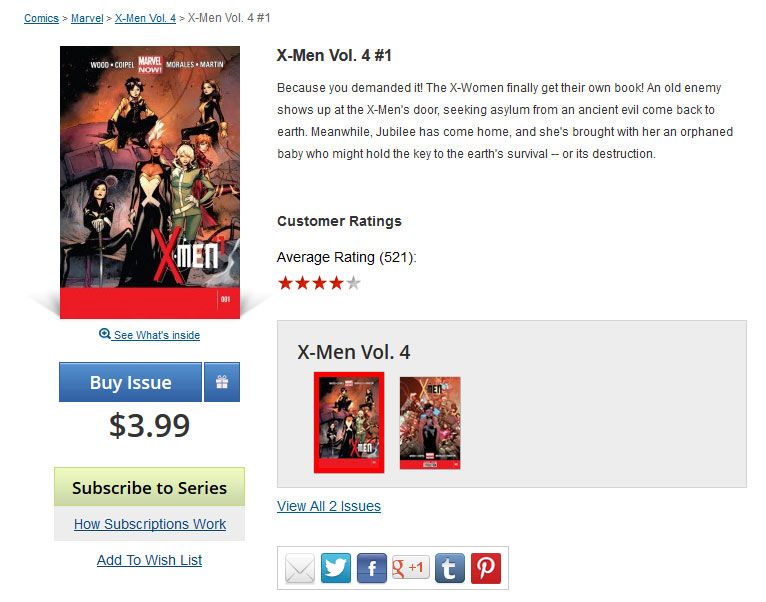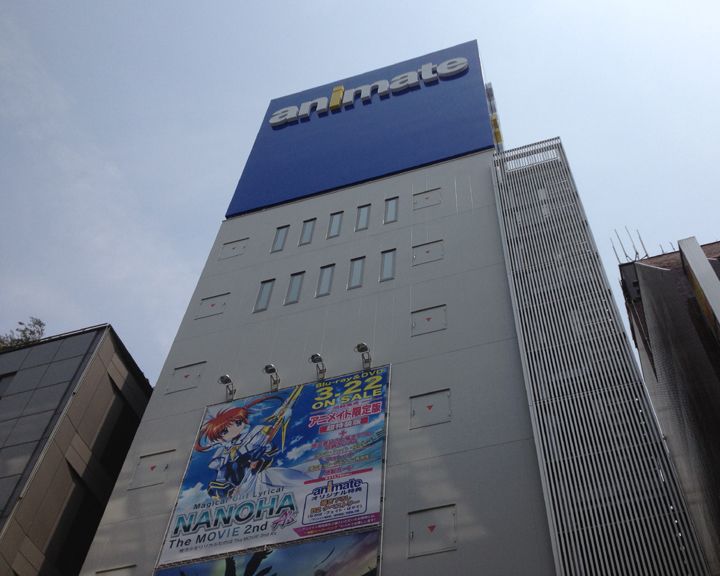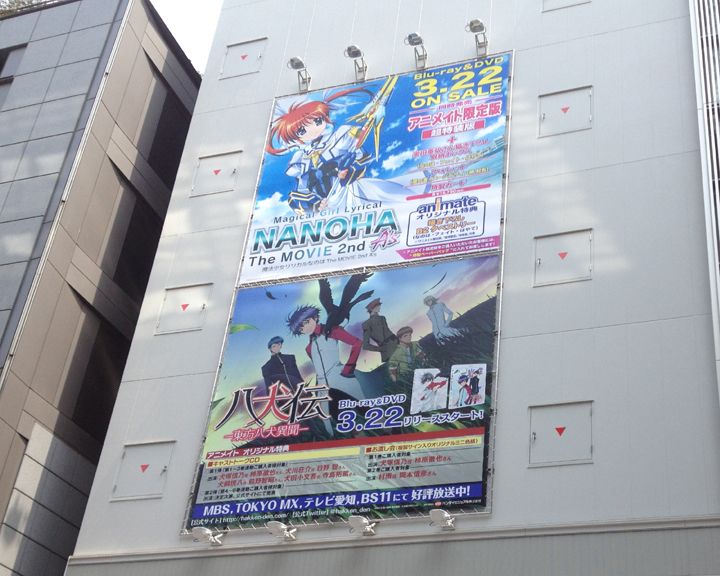I really wanted to buy the new all-female team X-Men title from the start, but $3.99 a pop is way too much to pay for a 22-page comic book.
In fairness to Marvel, I have paid the equivalent of eight dollars for a brand-new printed comic. As you know, I live in Japan and sometimes imported comics show up at bookstores with those kinds of mark-ups. I've bought comics for around five dollars at places like Blister. Scarcity and desperation played a role in my acceptance of those higher prices.
But now I find new comics readily available online, and vast back catalogs opening up there as well. After having spent a lot of money at Comixology and Dark Horse Digital, my price expectations are coming back down to earth.
It's relative to the package you get, as well. I'm pretty sure Woods's Conan the Barbarian came out at $3.50, which is still too expensive (and I bought those issues for more in yen), but the first story arc has the draw of Becky Cloonan artwork, plus some added value with the little Robert Howard comic strip and letter pages. Also, the print versions have a heftier feel than anything Marvel puts out and that makes higher prices a little easier to take. Now available digitally at a reduced price $2.99 each, they're still a bit of a wallet-strain, but Dark Horse has bundled three issues each into quite economical $4.99 packages. Customer relief!
Publishers frequently offer titles for .99 on Comixology, $1.99 is my favored "regular" point, and I can do $2.99 if it's really something special. But $3.99? For 22 pages? Well, most of us want things we can't have and so we make choices. For me, I also think it would be nice if Ferrari sold their cars for a dollar and we could all zoom around. But they don't (because they wouldn't be in business very long if they did something that stupid), so we don't. And while their comics certainly aren't as expensive to make as elite sports cars, Marvel, like Ferrari, knows what the market will bear and right now, that's $3.99 for most people not named Joel Bryan. Pricing a slender comic book this high makes my choice pretty easy. I still want to read this, but like the thrifty shopper I've become, I'll wait for a sale or the collection and buy that instead.
Being a comic book fan in Japan is no picnic. Unless you're reading your comic books outdoors, in the park, while eating sandwiches!
Friday, July 12, 2013
Thursday, June 20, 2013
They found some unpublished Osamu Tezuka art and stories...
This is a pretty big deal. Osamu Tezuka is probably the single most influential comic book creator bar none. In comic book terms, finding unpublished works by the "God of Manga" is the equivalent of finding a Leonardo DaVinci notebook. Some of the pages remain unfinished, but it's still charming, vigorous work. If you follow the link to the Asahi Shimbun main site you can read about the find in detail, but they limit how many articles you can read each month without paying for a subscription. In lieu of that just check out the pics on the page I've linked you to and marvel at just how good this guy was in his very early twenties-- a heck of a lot better than I am now at more than twice that age!
Wednesday, June 19, 2013
Hiroaki Komura: Sometimes you just have to go for it
As a kid, Hiroaki Komura loved to draw, but as an adult he found himself working as an auto mechanic instead of an artist. This happens to a lot of people. Not necessarily becoming auto mechanics, but drifting away from art in favor of more practical pursuits, or ones we perceive as more practical. I used to draw for hours a day when I was a child, but by the time I hit high school I began to meet resistance from my peers and to sense in the world little need for my meagre talents.
But we need art to keep beauty alive in a cold, mechanistic world, I told myself and anyone else who would listen. Great, the world replied, but can you eat art? I made a stab at becoming an illustrator by enrolling in the graphic design program at the University of Georgia, but despite having some top-notch illustrators as instructors and a chance to phone interview one of my idols, Jack Davis, the program's emphasis on page layout and typography-- the head of the program was a calligrapher, the most admired professor the creator of the Legacy typeface-- I came away disheartened, disillusioned and with my confidence badly shaken.
Low-paying "ad building" jobs at a couple of newspapers and another as a graphic artist at the university followed. I worked on art in my spare time, auditioned as an artist for an online web series called "Barbarian Moron" (I would have gotten it if I'd had Flash animation skills, darn it!) and did t-shirt designs for bands. I applied for jobs with game companies, with comics companies, wrote and re-wrote comic book series proposals and mailed them in with all the proper forms. By my mid-30s, I was living in Japan and teaching English, apparently destined to be just a comic book blogger rather than a creator. I still draw and I still write comics when I can find the time, though.
Komura got around the time management thing by just quitting his job and drawing. The thought of taking off a year and just devoting myself to my art is pretty tempting, but not very realistic. Harper Lee, for example, didn't just sequester herself and pump out To Kill a Mockingbird. She did that after friends offered her a year's salary so she could write uninterrupted each day. That's not going to happen for me, and even if it did, there's the matter of personal inertia. Would I buckle down and do the work when I've only done so haphazardly in all this time? I had my chance when I was working part-time and didn't make the most of it, so I have no one to blame but myself for not getting into the field.
Inker Bob McLeod told me on Facebook I have talent, but it confused him that I hadn't made more of an effort to get into the industry. I thought about my biography and while I can find all kinds of moments where I allowed other options to get me off track, the simple answer is I just didn't try hard enough. This guy Komura, on the other hand, made a gutsy decision and now he's living his dream.
I mean, being an auto mechanic is a pretty cool gig, too, but if you have art inside you, the only thing to do is to buckle down and make art. Make time, complete jobs. Mike Baron once wrote you should draw in your sketchbook as if you're getting paid to do it. Or something like that.
So learn from Hiroaki Komura and from me-- chase that dream!
But we need art to keep beauty alive in a cold, mechanistic world, I told myself and anyone else who would listen. Great, the world replied, but can you eat art? I made a stab at becoming an illustrator by enrolling in the graphic design program at the University of Georgia, but despite having some top-notch illustrators as instructors and a chance to phone interview one of my idols, Jack Davis, the program's emphasis on page layout and typography-- the head of the program was a calligrapher, the most admired professor the creator of the Legacy typeface-- I came away disheartened, disillusioned and with my confidence badly shaken.
Low-paying "ad building" jobs at a couple of newspapers and another as a graphic artist at the university followed. I worked on art in my spare time, auditioned as an artist for an online web series called "Barbarian Moron" (I would have gotten it if I'd had Flash animation skills, darn it!) and did t-shirt designs for bands. I applied for jobs with game companies, with comics companies, wrote and re-wrote comic book series proposals and mailed them in with all the proper forms. By my mid-30s, I was living in Japan and teaching English, apparently destined to be just a comic book blogger rather than a creator. I still draw and I still write comics when I can find the time, though.
Komura got around the time management thing by just quitting his job and drawing. The thought of taking off a year and just devoting myself to my art is pretty tempting, but not very realistic. Harper Lee, for example, didn't just sequester herself and pump out To Kill a Mockingbird. She did that after friends offered her a year's salary so she could write uninterrupted each day. That's not going to happen for me, and even if it did, there's the matter of personal inertia. Would I buckle down and do the work when I've only done so haphazardly in all this time? I had my chance when I was working part-time and didn't make the most of it, so I have no one to blame but myself for not getting into the field.
Inker Bob McLeod told me on Facebook I have talent, but it confused him that I hadn't made more of an effort to get into the industry. I thought about my biography and while I can find all kinds of moments where I allowed other options to get me off track, the simple answer is I just didn't try hard enough. This guy Komura, on the other hand, made a gutsy decision and now he's living his dream.
I mean, being an auto mechanic is a pretty cool gig, too, but if you have art inside you, the only thing to do is to buckle down and make art. Make time, complete jobs. Mike Baron once wrote you should draw in your sketchbook as if you're getting paid to do it. Or something like that.
So learn from Hiroaki Komura and from me-- chase that dream!
Monday, June 17, 2013
Tokyo Visionaries
This is something I wrote on my other blog a long time ago. I wonder if it still holds up?
As an American comic book fan living in Japan, I'm fascinated by depictions of my adopted home in my old favorites. My inspiration for living here is more pop cultural than spiritual or financial. I'm more of a live show and contemporary Tokyo person than a temple and garden type. And I'm not all that into manga or anime; I have a few favorites. No, my earliest imaginings of Japan consisted of images drawn from Speed Racer, Ultraman, Space Giants, Sonny Chiba movies, James Clavell's Shogun and-- for some reason-- Pink Lady.
As I got older, I became enamored of Japanese noise rock and street fashion, cinema and subcultures. I'd be lying, however, if I said in all of that I didn't find some inspiration from American comics and depictions of Japan found in them. These were and remain heavily reliant on Clavell-esque storylines of Westerners getting deeply involved with modern-day samurai, ninja or, in a more recent switch, yakuza gangsters seemingly born from both Michael Crichton's anti-Japanese paranoia-laced Rising Sun and Kitano Takeshi's ultra-violent films, among others-- the yakuza film is a longterm genre in Japan, just as gangster films have been in America for decades. Lots of arrogant, angry, high-strung characters like Silver Samurai, Katana, the female Dr. Light and occasional X-Men ally Sunfire, references to revered ancestors and "losing face" and "retaining honor" and life debts and all that junk...
Well, the chances of encountering genuine ninja in contemporary Japan are just about nil, and meeting up with yakuza thugs with ancestral castles only slightly more likely. But if the storylines are somewhat ridiculous, how do their visuals match up to the real thing? Let's take a look at some carefully selected examples. It's by no means a comprehensive overview because it consists only of comics I've actually read.
First up is the Chris Claremont-scripted, John Byrne-illustrated The Uncanny X-Men #118, "The Submergence of Japan." In this story, the X-people have escaped the Savage Land and traveled by the research ship Jinguichi Maru to Japan, where they find the ship's "home port of Agarashima," a fictional seaport ablaze in a fire so hot they can feel it from "ten kilometers from shore." Byrne treats us to an epic double-page splash with our heroes in the foreground, a backdrop of the devastated cityscape spewing massive, lurid red flames and billowing smoke, Air Self-Defense Force fighter jets streaking overhead and with a snow-covered Mt. Fuji off in the distance, as if gazing impassively at the destruction. The buildings are a little exotic-shaped, but it does give one a feeling of place; Agarashima, if it existed, would probably be somewhere on the southern coast of Honshu, somewhere between Shizuoka prefecture and Tokyo, an area where there are plenty of coastal cities hugged to the Pacific by mountains.
Coming ashore, the X-Men make their way through the ruins. Neither Claremont's narrative captions nor Byrne's art dwell much on travelogue, so we miss a chance to see if Byrne can match his ultra-detailed North American settings-- that counterfeiting of reality that adds so much verisimilitude to the X-Men's superheroic antics during this classic period-- with some postcard-perfect Japanese backgrounds, albeit ones crumbled by an earthquake. Byrne gives us just enough to make the setting at least seem real:
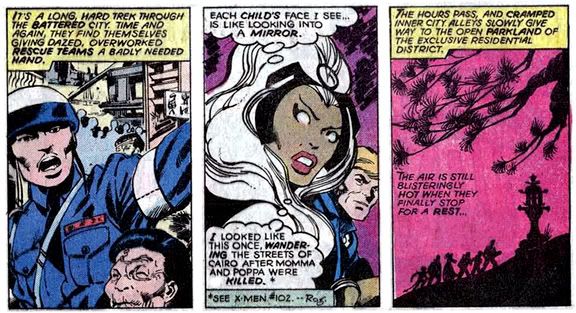
The story quickly replaces modern Japan with more James Clavell-style fantasies, and Byrne deftly draws all the shoji (paper sliding door) and wooden walkways you could desire in a comic book story before he and Claremont send their protagonists off to some secret island base to fight Moses Magnum, a nut who wants to sink Japan. Interestingly, this idea of Japan's submergence has been a theme in Japanese science fiction literature. Magnum's hideaway is right out of the 1967 James Bond adventure You Only Live Twice, also set in Japan and the poster for which carries Western sexual fetishization of subservient Japanese women to ludicrous extreme.
Sorry... I digress...
Even in such a fast-paced story, Wolverine finds time to meet and begin wooing a character who would become intrinsically linked with him, at least throughout the 1980s, Lady Mariko Yashida. He even presents her with a chrysanthemum and displays a heretofore unknown ability to speak perfectly fluent Japanese!
In the 1982 Wolverine miniseries, Claremont teams up with the artist most known in America for the influence of Japanese comics and cinema on his stories, Frank Miller. Together, they send Wolverine on a very Bond-like adventure in a modern day Japan practically overrun by crazed ninja assassins. This story is like a compendium of the American popular mythologizing of Japanese culture-- all samurai honor and Asian exoticism but set against the sleek electric cityscapes of the late 20th century. Clavell meets William Gibson, with Sonny Chiba as interlocutor.
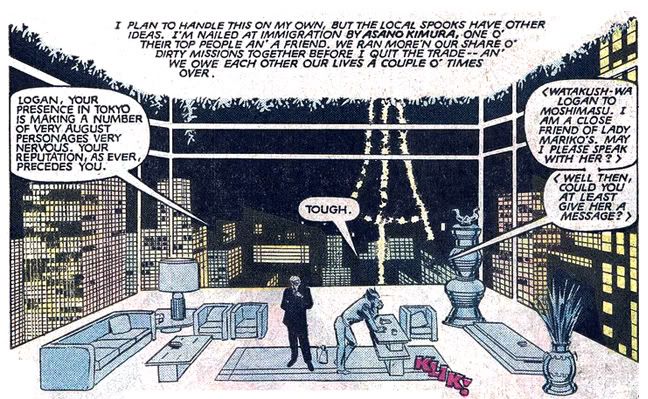
In this image, Wolverine has checked into either an upscale apartment or the fanciest hotel on earth. It appears to be in Minato ward, because that's Tokyo Tower in the background. Minato is home to Roppongi and Roppongi Hills and in places is pretty much the skyscraper forest Miller illustrates here. Later, Wolverine finds himself drunk in an "alley off the Ginza." Ginza is a shopping district within the Chuo ward. I've never heard it referred to as "the Ginza," but who knows?
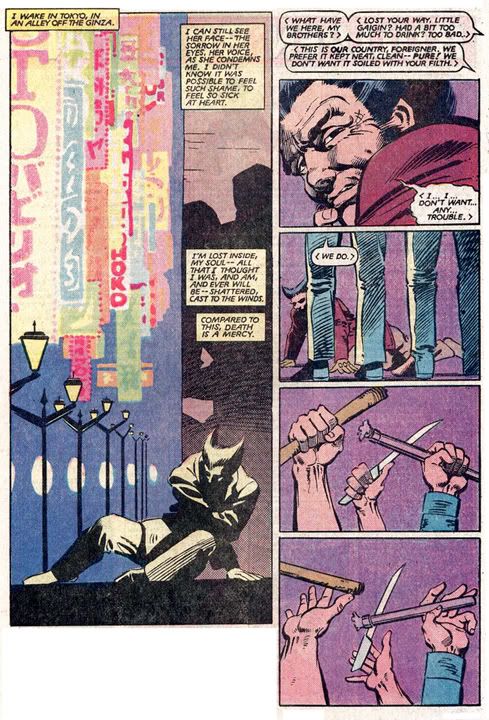
While I'm doubtful about the presence of anti-foreigner thugs in that particular area of Tokyo, again Miller's backgrounds prove surprisingly accurate:
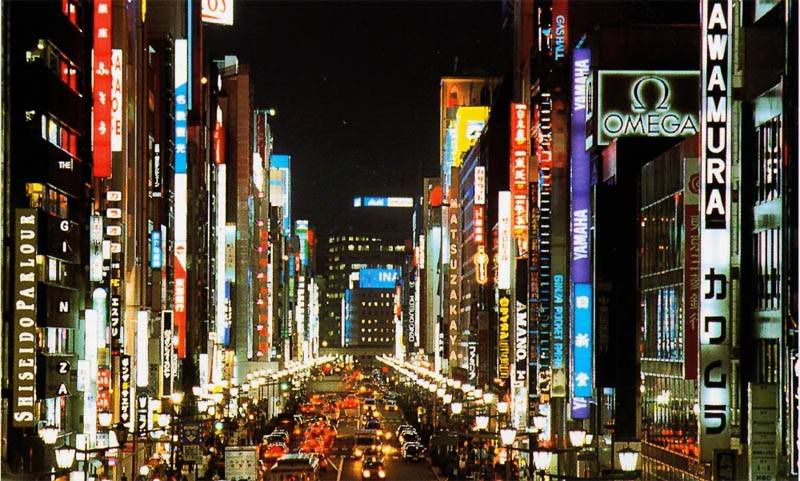
Not too shabby, eh? He even appears to have gotten the streetlamps correct. Still, I think if Wolverine were really looking to get his drunk on in a seedy part of Tokyo, he would have been better off hitting Kabuki-cho in Shinjuku. Ginza features its share of hostess bars, but is a bit more upscale and pricey. Kabuki-cho is often referred to by my students and friends here as the "most dangerous place in Japan." It's a down-and-dirty fun zone where at night you can see prostitutes, street-level yakuza, Nigerian gangsters and perhaps even members of Chinese tongs if you're lucky. They'll be mixed in with lots of businesspeople doing the after-work drinking thing and young couples in search of exciting nightlife so you may not even notice them. Sounds more like a Wolverine kind of place.
This is interesting:
 As Claremont describes it in the caption, Meguro is indeed an "upper class" area. A number of celebrities make their homes there. What you need to remember, however, is the phone-shaped building. It will become important later.
As Claremont describes it in the caption, Meguro is indeed an "upper class" area. A number of celebrities make their homes there. What you need to remember, however, is the phone-shaped building. It will become important later.The story's climax and closing actions take place within the castle-like Yashida family "ancestral stronghold." Miller's architecture even more accurate here, but given the unfortunate destruction of most castles during the Meiji Period and flattening of Japan's major cities during WWII, it's pretty unlikely any private family would be living in something so... historical. In comic books as in life, sometimes coolness must trump accuracy. Would you want to read a story where a vengeful Wolverine scales the less-than-impressive walls of a fancy apartment building?
Perhaps, but Wolverine in a Edo-style castle is a bit more visually interesting.
The 1980s were prime time for Japanese influences in American pop culture. The decade began with the hugely successful TV miniseries adaptation of Clavell's Shogun and the major failure of Pink Lady and Jeff, a bizarre yet energetic attempt to make two talented J-Pop singers variety stars in the States. Later American television audiences would pretty much ignore The Master, an absolute bullshit adventure TV series starring Lee Van Cleef as a blue-eyed ninja; it would last a mere thirteen episodes and become Mystery Science Theatre 3000 fodder. This probably says as much about Western cultural misappropriation as having Canadian-born Wolverine described as "more truly Japanese than any Westerner I have ever known" by one of his allies. At least Claremont qualifies it somewhat. Wolverine can master the language and cultural mores, defeat the yakuza boss and win the hand of the nigh-unreachable Lady Mariko, but as a mutant as well as gaijin, he remains an outsider in Japan as well as in the West. Lee Van Cleef bests even the Japanese at their own martial arts, then walks away for personal reasons.
But I digress yet again...
Perhaps inspired by Wolverine's Japan sojourn, Batman would take his Outsiders to Tokyo in 1984's Batman and the Outsiders #11. In this story writer Mike W. Barr and penciller Jim Aparo tackle the increasingly cliche story themes of the Japanese concept of honor and family loyalty as native-born Japanese Katana (described the following issue as the "She-Samurai") confronts her past and we learn all about her magical sword. The story is heavy on the ninja tropes but how do Aparo's Tokyo cityscapes fare as accurate depictions of that particular megalopolis?
Not too badly, if this image is any clue:
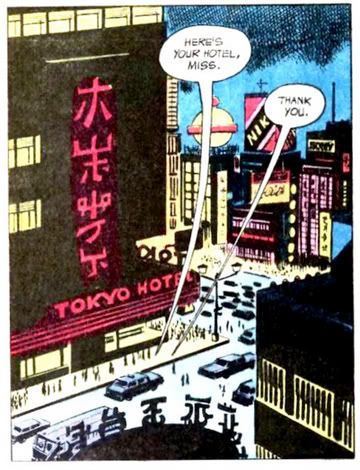 He gets the omnipresent advertising signs correct. Many buildings here do feature giant signage on their rooftops and various kanji and katakana or hiragana running down their sides. This particular panel is somewhat reminiscent of the Kabuki-cho side of Shinjuku Station, although there's no "Tokyo Hotel" in the station, and there'd be a small plaza to the right instead of what appears to be a parking lot of some kind. Those types of lots are extremely rare here in land-starved Japan; more likely would be a high-rise parking deck looking like a big steel Rubik's Cube, but not nearly so colorful.
He gets the omnipresent advertising signs correct. Many buildings here do feature giant signage on their rooftops and various kanji and katakana or hiragana running down their sides. This particular panel is somewhat reminiscent of the Kabuki-cho side of Shinjuku Station, although there's no "Tokyo Hotel" in the station, and there'd be a small plaza to the right instead of what appears to be a parking lot of some kind. Those types of lots are extremely rare here in land-starved Japan; more likely would be a high-rise parking deck looking like a big steel Rubik's Cube, but not nearly so colorful.And again:
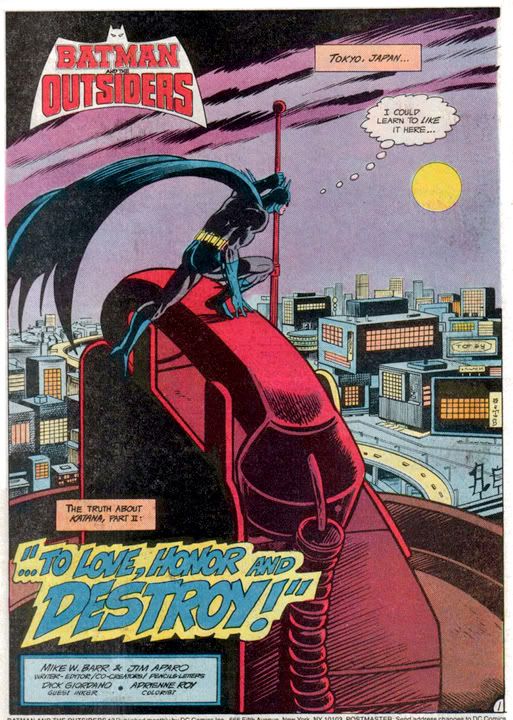
I have no idea if there is now or if there ever was a building with a gigantic telephone on top, but Frank Miller and Jim Aparo seem to insist upon its existence. Maybe it was a famous landmark of the 1970s and 1980s and both artists saw it on some kind of comic book publicity junket here. Or else Aparo is paying homage to the work Miller did with Chris Claremont. Since this story hits some of the same cultural notes, that's a distinct possibility. Aparo's buildings are a far cry from the Meguro seen in Wolverine, though. This looks more industrial (and generic) than "upper class," so perhaps the phone building is merely a fantasy.
A more recent comic book look at Tokyo comes courtesy Vertigo Pop: Tokyo! by Jonathan Vankin and Seth Fisher. Vankin's story is another "Japan-as-other" fantasia, this time seen not through the eyes of superheroic adventurers but those of an ordinary American electronics geek. To that end, Vankin's protagonist is somewhat dull and colorless, his Japanese are laughable flakes and the story is a vibrant romp through newer paradigms of our outsider's view of contemporary Japan. As someone who actually lived in Japan, Vankin obviously has an encyclopedic knowledge of Japanese pop culture and presents it in a comically extreme form for our amusement. Gone are the samurai and ninja, replaced by ditzy fashion girls and would-be flight attendants, incompetent gangsters, sci-fi pop stars, perverted old men and fast food restaurants. Candy-colored Japan.
I don't know if it's exacly an improvement, but it is closer to what you might actually find if you came here.
Like Vankin, Fisher (who tragically passed away much too young) actually lived in Japan, so I imagine he was able to do a lot more first-hand location scouting than Byrne, Miller or Aparo. Consequently, despite the story's comedic exaggeration, Fisher's Tokyo is almost documentarian in its accuracy. Oh, like Vankin, Fisher takes some license here and there, but only in the service of the narrative. Here's his version of Ikebukuro, one of Tokyo's busiest but somewhat second-rate districts. Sorry, Ikebukuro! I love you but I mean "second-rate" compared to trendier wonderlands like Shinjuku, Shibuya and Harajuku:
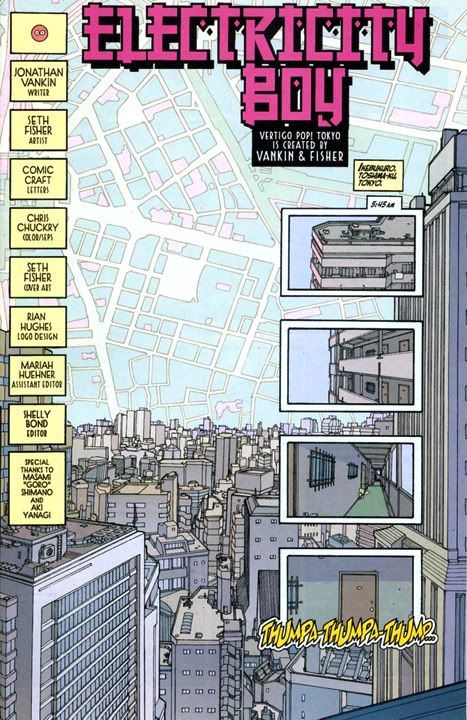
To my eyes, the backstreets of Tokyo-- the places where people actually work and live as opposed to shop and play-- look like this. A bewildering jumble of high-rise buildings in dull concrete, stretching from horizon to horizon. No comic book story (and few movies) can prepare you for Tokyo's immense scale. Once inside, you are in an artificial world of steel and glass and after a while, it's hard to imagine there are any other environments on earth.
Here's a photo I took in Ikebukuro:
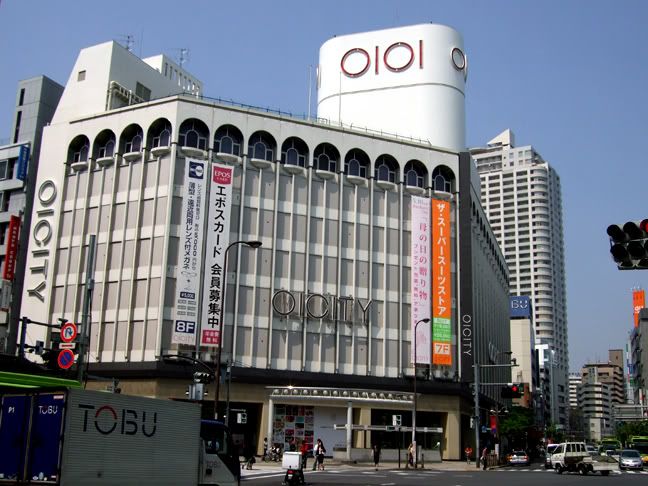
As Vankin's story unfurls, Fisher treats us to backdrops of some of the coolest places on earth. Here's a panel where crazed schoolgirl (another trendy stereotype) Maki has kidnapped her idol Hike to show him off to her Harajuku girl friends. This is more than likely Takeshita-dori, which during the 1990s was the epicenter of Japanese youth fashion culture:
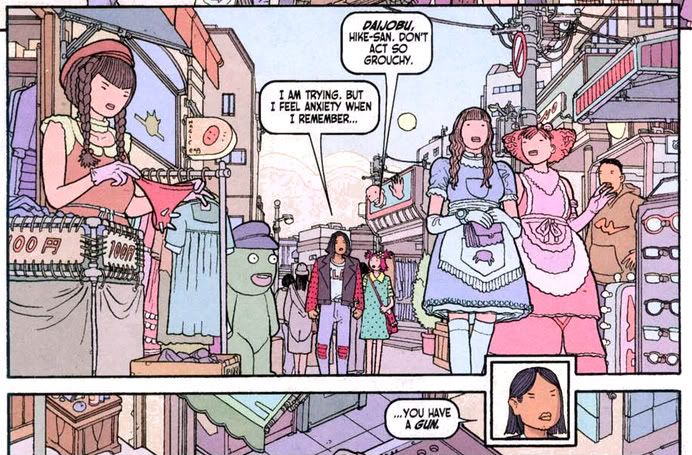
That's one problem with Vertigo Pop: Tokyo!-- Japan's trends change so fast what was current as recently as 2002 is practically antediluvian now. And a lot of the elements in the story seem more contemporaneous with the mid- to late-1990s. Well, perhaps not a problem, per se, but more a transmuting it to a kind of literary time capsule or period piece. Jidai geki for the visual-kei set. And here's the real Takeshita-dori as it appears today:
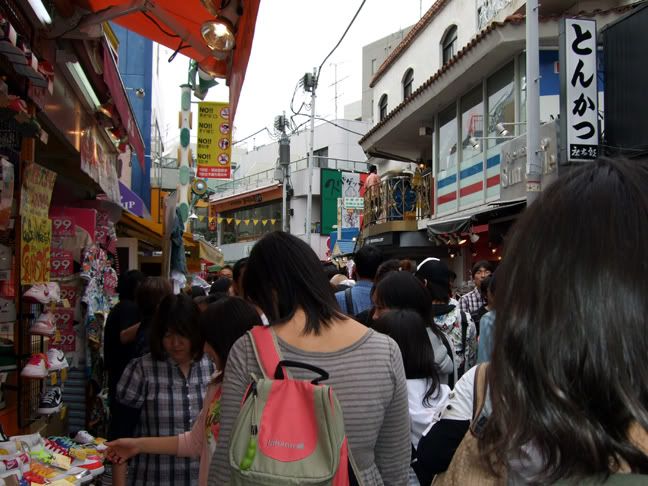
As you can see, Fisher pretty much nails it and I was standing in almost the exact same spot the panel appears to depict. If an artist draws Takeshita-dori as crowded as it truly is, we wouldn't be able to see the main characters at all. Behold Takeshita-dori in all her glory:
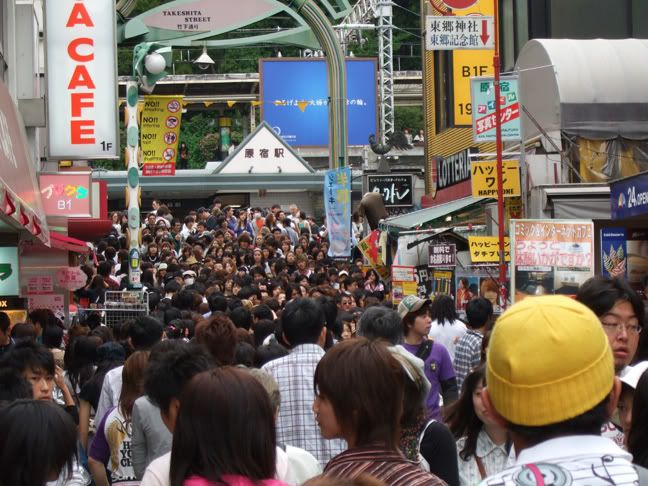
It can take you thirty minutes to an hour to walk its length on the weekend. Unfortunately for this story (and Gwen Stefani), the classic Maki-style "Harajuku Girl" doesn't really exist in that form anymore. She's been name-branded out of existence in Harajuku, subsumed by gothic lolitas and cosplayers and driven by photo-happy tourists to quieter, trendier neighborhoods like Kichijoji (where my own personal version of Maki eventually settled). But FRUiTS magazine continues to document her colorful, creative stylistic heirs faithfully so there's still some hope. Here's an image set just outside Yoyogi Park proper, crossing the Yamanote Line rails in Harajuku:
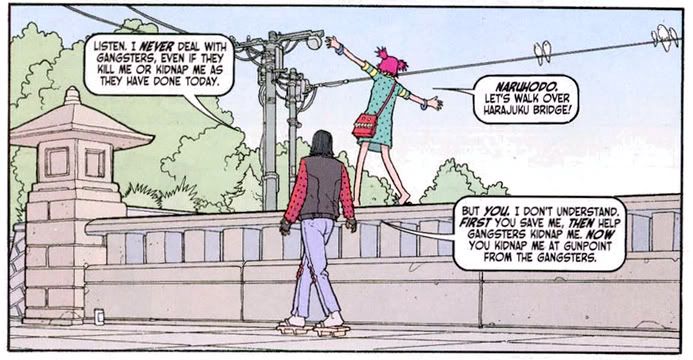
Here's the park itself, in reality. Fisher almost perfectly matches the real-life location. The lower wall is bit taller in the real world and there are some slight differences in the end caps, but it's instantly recognizable:
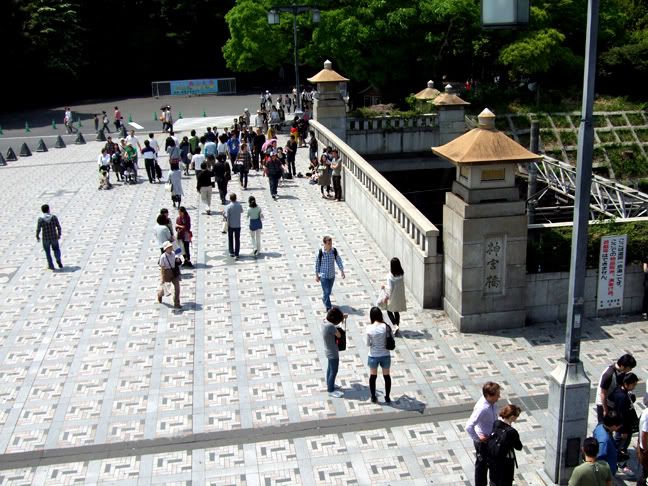
You can even spot the exact location crazy-pops Maki daringly tightrope walks along the wall. It's roughly between the guy in the light shirt and khaki slacks and the person in the face mask in this photo:
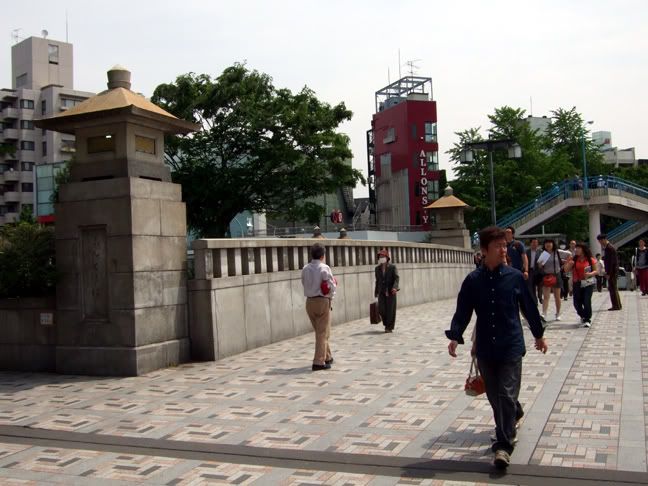
But I don't advise you to duplicate her stunt. On the other side of that wall are the Yamanote Line train tracks and it's quite a drop. Part of the action takes place on the pedestrian bridge overlooking the park:

I end up on this bridge every time I visit Tokyo so I can attest to Fisher's accuracy, even with a bit of artistic license. While the color is wrong (although it may have changed from 2002, the year the story is set, to today), Fisher gets the basic look of the bridge itself down, and even includes some of the surrounding greenery:
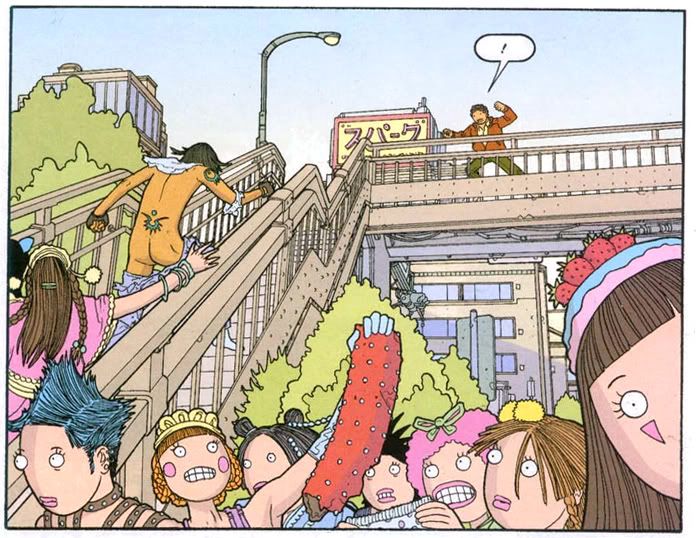 There's one moment where two characters fall off the bridge and land in the park plaza below, which is almost impossible. The bridge doesn't span the park; it crosses the street over a busy intersection. If they'd have fallen, they would've instantly been run over by cars, as you can see here:
There's one moment where two characters fall off the bridge and land in the park plaza below, which is almost impossible. The bridge doesn't span the park; it crosses the street over a busy intersection. If they'd have fallen, they would've instantly been run over by cars, as you can see here: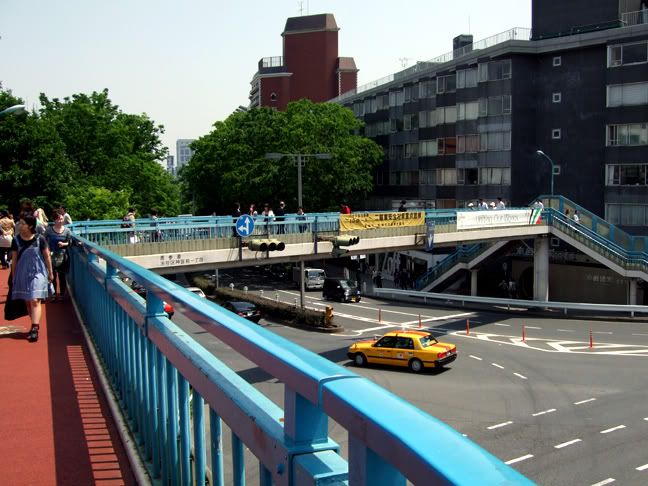
Also, notice that it's not a single span but several, in a rectangular shape. Here's in interesting scene where a nearly naked Maki attempts to escape the chaos she herself has caused, dragging a completely nude Hike behind:
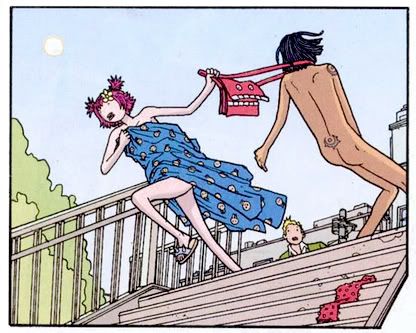
And this is my best guess as to where this event occurs:
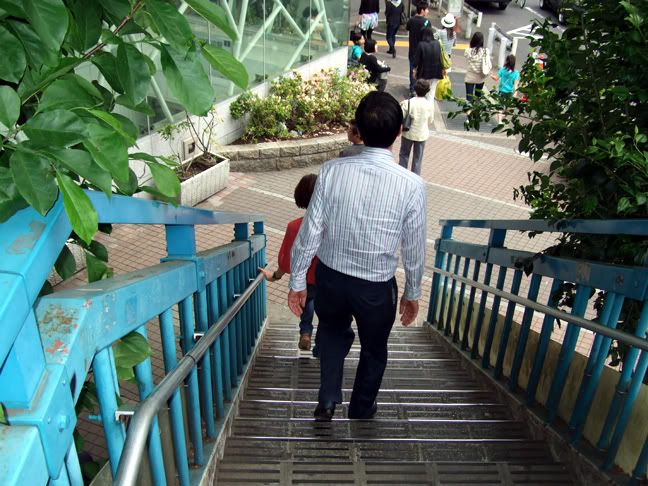
I stupidly shot this photo from the top rather than matching the comic book panel's lower angle from the bottom. Oh well, maybe next time.
So how do our comic book artists fare with their depictions of Tokyo? Not bad at all. Fisher obviously takes the prize, but the old school dudes pleasantly surprised me. In my memory, they were all much less accurate but I'm gratified to be wrong and actually able to praise these guys for how "right" they got Tokyo rather than rag on them for falling far short. Sure, each could've done a bit more research and gotten it exact, but I doubt either Marvel or DC were willing to spend that kind of money for location sketching. Plus deadlines and all.
Remember-- it's pretty easy for a writer to type "Wolverine hops a jet and lands in Tokyo, then takes a taxi to Shinjuku. On the way there, fighting jet lag, he marvels at his own face gazing down at him from various advertisements in the wild neon lights down the sides of buildings along the street," but the artist has to take those words and make them at least somewhat visually plausible. And Byrne, Miller, Aparo and Fisher accomplish that with their work in these books.
I still have this desire to find some of the actual locations from Yazawa Ai's glorious comic book creation Nana, including Jackson Hole where I plan to try a Jackson Burger (Hachi swears by 'em). Yazawa gets around the accuracy and time constraint issues by using actual photographs as her backgrounds. Until then:
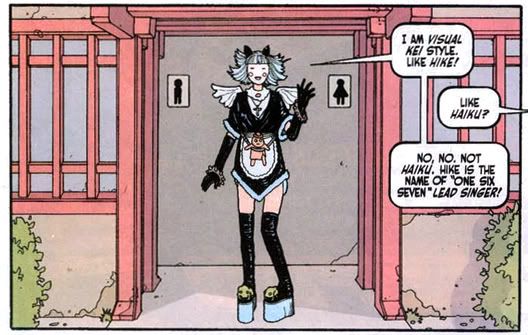 Bai-bai!
Bai-bai!
Wednesday, June 12, 2013
Everything I've bought lately has been from Comixology...
As we've discussed, your choices for print versions of your favorite American mainstream and smaller-press comics in Japan are very limited. As in almost non-existent. You can find some online retailers and pay massive shipping costs or you can buy digitally. The latter is what I've settled on doing through Comixology and, to a lesser extent, the also nifty Dark Horse online store.
While I don't mean to shill for Comixology-- not being able to download your comics to read them offline is a major irritant I have with them, after all-- or for Dark Horse-- same deal-- as a comic fan in Japan, those are really the only games in town. Strangely enough, after years of accumulating actual hold-in-your-hand comic magazines stored in the classic "longbox," I now have the most extensive comic book collection of my life in digital form. I own comics I could only dream about having-- key books from the Golden Age, almost three dozen Fantastic Fours by Stan Lee and Jack Kirby, complete runs of favorite titles from my childhood and teenage years plus a scattering of random choices from some newer offerings. And even though I'm not a supporter of what Marvel and DC are doing these days, I am buying a few individual issues just to keep up with developments or because I like a particular character or other.
Dani Moonstar and Katana, I'm looking at you!
I haven't spent as much money at Dark Horse, but there's no reason for that beyond my obsession with books like Kamandi and The Walking Dead, which you can only buy from Comixology. Eventually I'll hit Dark Horse up for all the Hellboy and Conan titles they carry, plus those Creepy and Eerie collections I love. In the meantime, Comixology also offers IDW and Fantagraphics products, Image, The Rude Dude Productions Nexus issues and their new self-submission titles, some of which are worth reading.
If you're living here in Japan and you're interested, you need to check out both Comixology and Dark Horse.
While I don't mean to shill for Comixology-- not being able to download your comics to read them offline is a major irritant I have with them, after all-- or for Dark Horse-- same deal-- as a comic fan in Japan, those are really the only games in town. Strangely enough, after years of accumulating actual hold-in-your-hand comic magazines stored in the classic "longbox," I now have the most extensive comic book collection of my life in digital form. I own comics I could only dream about having-- key books from the Golden Age, almost three dozen Fantastic Fours by Stan Lee and Jack Kirby, complete runs of favorite titles from my childhood and teenage years plus a scattering of random choices from some newer offerings. And even though I'm not a supporter of what Marvel and DC are doing these days, I am buying a few individual issues just to keep up with developments or because I like a particular character or other.
Dani Moonstar and Katana, I'm looking at you!
I haven't spent as much money at Dark Horse, but there's no reason for that beyond my obsession with books like Kamandi and The Walking Dead, which you can only buy from Comixology. Eventually I'll hit Dark Horse up for all the Hellboy and Conan titles they carry, plus those Creepy and Eerie collections I love. In the meantime, Comixology also offers IDW and Fantagraphics products, Image, The Rude Dude Productions Nexus issues and their new self-submission titles, some of which are worth reading.
If you're living here in Japan and you're interested, you need to check out both Comixology and Dark Horse.
Tuesday, April 30, 2013
Comics shopping in Tokyo: April 2013
Well, I gave it a try. As soon as I hit Tokyo, I went to Monster in Ebisu. They had a very few new comics, some back issues that were all from this year and a small selection of graphic novels and trade collections. Despite not finding a huge wall of comics, I still managed to spend 8,100 yen. I bought as many Boom! Studios Peanuts as I could find-- Peppermint Patty in dress?-- plus the second and third issues of Marvel's Fearless Defenders and two issues of Dark Horse's new Star Wars ongoing, along with some other books I probably never would have bought save for desperation. Monster has some 200 yen issues, but most comics will cost you between 420-480 yen or so. That's nothing unusual for Japan.
Monster was a very cool shop to hang out in even if the comic book selection was pretty slender. It's easy to find, only a minute or so from Ebisu station-- right on the Yamanote Line, so there's no chance of getting lost-- and the store is absolutely jam-packed with superhero and movie toys. They seem to specialize in Star Wars but they had a lot of DC and Marvel action figures and statues, plus all kinds of other neat little items. This stuff isn't cheap, but Monster is worth a stop if you're jonesing for little Luke Skywalkers (or that mega-expensive two-figure 1/6th scale Bespin Luke from Hot Toys; he was in stock), die cast metal Batmobiles or plastic figures of Wonder Woman in her new costume. Or if you just like looking at such things. I was hoping they might have the new Dani Moonstar action figure, and while they did have others from that series (with her picture on the back of the package), she was nowhere to be found. Heartbreaking!
The customers were nice, a mixed crowd of young men and women, some parents and their little kids browsing and having pop culture fun. I also found the staff very pleasant. Big smiles and arigato gozaimashitas to seal the deal. I had a great time there, and I can't say I was disappointed not to find a massive selection of new and old comics. I didn't have much expectation of that in the first place. Still, I'll be making regular visits to Monster when I go to Tokyo. It beats hauling my butt all the way to Akihabara to see the same things, plus there are a lot of intriguing restaurants on the same street.
With Blister closed for the weekend, my only other choice was to find Manga No Mori in Ikebukuro. This proved an exercise in frustration. I finally located its former location, which is now a K-Books Men's. They sell those plastic statues and artwork of cutie-pie nearly-nekkid anime/manga girls. Kind of ironic, when one of the draws of Manga No Mori was its reputation for catering to female customers. I didn't expect to find any Cass there-- another shot in the dark-- but I had hoped to find the store at least. Since I'm not into the kind of stuff they sell, I didn't linger at K-Books Men's.
Speaking of catering to female comic customers, visiting the huge Animate in Ikebukuro was a highlight. First of all, just look at it!
That is one mammoth slab of comic book fun. Are there comic book shops this large in the United States? I tend to doubt it, and I doubt if there were they'd be as crowded as Ikebukuro's Animate shop. Just the line for the elevator made it seem like an amusement park attraction. I opted for the steps.
I didn't take any photos inside because I thought it would be rude, but there were plenty of people inside who had no qualms about snapping away. Now I'm thinking it was a missed opportunity. I mean, this place was just bustling and the lines for the cash registers on each floor made looking at merchandise difficult, like trying to watch a baseball game through a wooden fence.
And yes, most of the customers-- but not all-- were women and girls. A very bright, cheerful environment and as many comics about boys kissing boys as you could read in a lifetime. All in Japanese, of course. There is a floor for guy comics, too. And a section with manga-making supplies like paper, pencils, all kinds of ink pens, comic-making computer programs, color markers and more.
I'd read many times about Otome Road, the girly version of Akihabara. Having experienced the dude side in Akiba a few times, I was curious to see how the other half lives. Well, I must be an idiot because I couldn't find it. Others who are smarter than I am have had better luck and you can read about their happier experiences elsewhere. I'm more than a little disappointed I didn't get to visit any cosplay shops there, but if you look at my last photo you can see a brown van parked just in front of the main entrance of Animate. That's for buying food and the young women running it might have been cosplayers. I saw some startlingly white hair. Just down the street was a small park with its own festival in progress.
There I definitely saw some cosplayers. They were having a photo session. I strolled by just to check them out. So I suppose my story has a happy ending after all.
Monster was a very cool shop to hang out in even if the comic book selection was pretty slender. It's easy to find, only a minute or so from Ebisu station-- right on the Yamanote Line, so there's no chance of getting lost-- and the store is absolutely jam-packed with superhero and movie toys. They seem to specialize in Star Wars but they had a lot of DC and Marvel action figures and statues, plus all kinds of other neat little items. This stuff isn't cheap, but Monster is worth a stop if you're jonesing for little Luke Skywalkers (or that mega-expensive two-figure 1/6th scale Bespin Luke from Hot Toys; he was in stock), die cast metal Batmobiles or plastic figures of Wonder Woman in her new costume. Or if you just like looking at such things. I was hoping they might have the new Dani Moonstar action figure, and while they did have others from that series (with her picture on the back of the package), she was nowhere to be found. Heartbreaking!
The customers were nice, a mixed crowd of young men and women, some parents and their little kids browsing and having pop culture fun. I also found the staff very pleasant. Big smiles and arigato gozaimashitas to seal the deal. I had a great time there, and I can't say I was disappointed not to find a massive selection of new and old comics. I didn't have much expectation of that in the first place. Still, I'll be making regular visits to Monster when I go to Tokyo. It beats hauling my butt all the way to Akihabara to see the same things, plus there are a lot of intriguing restaurants on the same street.
With Blister closed for the weekend, my only other choice was to find Manga No Mori in Ikebukuro. This proved an exercise in frustration. I finally located its former location, which is now a K-Books Men's. They sell those plastic statues and artwork of cutie-pie nearly-nekkid anime/manga girls. Kind of ironic, when one of the draws of Manga No Mori was its reputation for catering to female customers. I didn't expect to find any Cass there-- another shot in the dark-- but I had hoped to find the store at least. Since I'm not into the kind of stuff they sell, I didn't linger at K-Books Men's.
Speaking of catering to female comic customers, visiting the huge Animate in Ikebukuro was a highlight. First of all, just look at it!
That is one mammoth slab of comic book fun. Are there comic book shops this large in the United States? I tend to doubt it, and I doubt if there were they'd be as crowded as Ikebukuro's Animate shop. Just the line for the elevator made it seem like an amusement park attraction. I opted for the steps.
I didn't take any photos inside because I thought it would be rude, but there were plenty of people inside who had no qualms about snapping away. Now I'm thinking it was a missed opportunity. I mean, this place was just bustling and the lines for the cash registers on each floor made looking at merchandise difficult, like trying to watch a baseball game through a wooden fence.
And yes, most of the customers-- but not all-- were women and girls. A very bright, cheerful environment and as many comics about boys kissing boys as you could read in a lifetime. All in Japanese, of course. There is a floor for guy comics, too. And a section with manga-making supplies like paper, pencils, all kinds of ink pens, comic-making computer programs, color markers and more.
I'd read many times about Otome Road, the girly version of Akihabara. Having experienced the dude side in Akiba a few times, I was curious to see how the other half lives. Well, I must be an idiot because I couldn't find it. Others who are smarter than I am have had better luck and you can read about their happier experiences elsewhere. I'm more than a little disappointed I didn't get to visit any cosplay shops there, but if you look at my last photo you can see a brown van parked just in front of the main entrance of Animate. That's for buying food and the young women running it might have been cosplayers. I saw some startlingly white hair. Just down the street was a small park with its own festival in progress.
There I definitely saw some cosplayers. They were having a photo session. I strolled by just to check them out. So I suppose my story has a happy ending after all.
Wednesday, April 24, 2013
On the mechanics of anime illustration - The Japan Times
On the mechanics of anime illustration - The Japan Times
Japan has to be the top comic/animation loving nation in the world. I have no statistics to back this up. For all I know, it may actually be China or South Korea or even France. But I do know comics and animation are mainstreamed here in Japan in ways denied by audiences in my native US, despite the media's discovery every three or four years that "BAM! POW! Comics aren't just for kids anymore!" and libraries stocking graphic novels.
Publishers of super grown-up type books like Penguin Group (USA) occasionally take initiatives to broaden the appeal of comics. And so do publishers like Scholastic for younger readers. They offer comic books through their ingeniously titled graphic novel divisions or imprints. And remember DC's late, lamented Minx line? They advertised in teen fashion catalogs, which probably seemed like a great idea at the time. Graphic novels and comics-- especially the monthly ones-- still tend to be a niche product, with a shelf or two of the most obvious titles at what few brick-and-mortar bookstores that remain in your malls and shopping centers. People will watch uneven TV shows and go by the millions to craptacular movies based on them, but publishers have to push the idea that comics can be about anything and read by anyone. They make huge noise whenever they do, and their best intentions still don't always pan out.
While here in Japan, almost every bookstore you go to has huge comic book sections with a wide range of genre titles available.
Anyway, this rant comes inspired by the Japan Times, which ran the story linked way up top there about a museum exhibition of the works of Kunio Okawara, who designed giant robots for Mobile Suit Gundam and created a phenomenon. While I don't know a whole lot about his career, even a cursory glance at Japan reveals his pervasive influence. The news article catalogs some of it briefly, and it's breath-taking. I'd say a lot of what we Americans think about Japanese pop culture is a result of Okawara's work even if we've never actually laid eyes on a Gundam model kit. If you've ever watched that South Park where they satirize Pokemon or that one The Simpsons where they watch Battling Seizure Robots or the other one where they go to the Totally Sick, Twisted, F***ed-Up Animation Festival, then you've been exposed to Okawara in some small way.
What does any of this have to do with graphic novel imprints? Eh, probably nothing. I just wanted to show you how what in the US is considered entertainment for a specific audience is mass entertainment in Japan. Not that everyone here sits around building Gundam models-- although a character SMAP star Shingo Katori plays on a recent TV drama does in his free time, when he's not talking to his beautiful ghost roommate (and even when he is)-- or reading comics, but in Japan, you're just much more likely to see a train load of teen girls into comics US publishers find so elusive, or run into the middle aged dude who spends a lot of money on plastic toys and isn't considered a weirdo. It's still not cool to achieve the status of otaku, but you can indulge your geek-tooth without having to explain to people this stuff is for grown-ups, too.
And that suits me just fine.
Japan has to be the top comic/animation loving nation in the world. I have no statistics to back this up. For all I know, it may actually be China or South Korea or even France. But I do know comics and animation are mainstreamed here in Japan in ways denied by audiences in my native US, despite the media's discovery every three or four years that "BAM! POW! Comics aren't just for kids anymore!" and libraries stocking graphic novels.
Publishers of super grown-up type books like Penguin Group (USA) occasionally take initiatives to broaden the appeal of comics. And so do publishers like Scholastic for younger readers. They offer comic books through their ingeniously titled graphic novel divisions or imprints. And remember DC's late, lamented Minx line? They advertised in teen fashion catalogs, which probably seemed like a great idea at the time. Graphic novels and comics-- especially the monthly ones-- still tend to be a niche product, with a shelf or two of the most obvious titles at what few brick-and-mortar bookstores that remain in your malls and shopping centers. People will watch uneven TV shows and go by the millions to craptacular movies based on them, but publishers have to push the idea that comics can be about anything and read by anyone. They make huge noise whenever they do, and their best intentions still don't always pan out.
While here in Japan, almost every bookstore you go to has huge comic book sections with a wide range of genre titles available.
Anyway, this rant comes inspired by the Japan Times, which ran the story linked way up top there about a museum exhibition of the works of Kunio Okawara, who designed giant robots for Mobile Suit Gundam and created a phenomenon. While I don't know a whole lot about his career, even a cursory glance at Japan reveals his pervasive influence. The news article catalogs some of it briefly, and it's breath-taking. I'd say a lot of what we Americans think about Japanese pop culture is a result of Okawara's work even if we've never actually laid eyes on a Gundam model kit. If you've ever watched that South Park where they satirize Pokemon or that one The Simpsons where they watch Battling Seizure Robots or the other one where they go to the Totally Sick, Twisted, F***ed-Up Animation Festival, then you've been exposed to Okawara in some small way.
What does any of this have to do with graphic novel imprints? Eh, probably nothing. I just wanted to show you how what in the US is considered entertainment for a specific audience is mass entertainment in Japan. Not that everyone here sits around building Gundam models-- although a character SMAP star Shingo Katori plays on a recent TV drama does in his free time, when he's not talking to his beautiful ghost roommate (and even when he is)-- or reading comics, but in Japan, you're just much more likely to see a train load of teen girls into comics US publishers find so elusive, or run into the middle aged dude who spends a lot of money on plastic toys and isn't considered a weirdo. It's still not cool to achieve the status of otaku, but you can indulge your geek-tooth without having to explain to people this stuff is for grown-ups, too.
And that suits me just fine.
Sunday, April 21, 2013
Monster in Ebisu! (Don't worry-- it's only a toy store with American comics)
Okay, for the longest time I've been claiming Blister in Nihonbashi was the only place to get American comics in Tokyo. By comics I mean the newest monthly issues, not the trades; tons of those can be had at Tower Records (Shibuya) and Kinokuniya (various, but Shinjuku is probably the one you want). I'm happy to say I was (more than likely) wrong about that. I have to go to Tokyo for some official business this weekend and since Blister is closed the days I'll be there, I started doing some Internet searches for other possible sources for four-color amusements of the super-caped-heroic kind. Or possibly the Hellboy-ish.
To get to the point, I found a nice blog by someone named Filipo who apparently lives in Japan and collects comics. Filipo missed a chance at Blister (the dreaded orange wall of closure gives me the willies), but found a place called Monster, located in Ebisu. Monster is mostly a toy shop but they have a small selection of American comics. Actually, from Filipo's description, Monster seems pretty much like Blister. Maybe not as ambitious as the original Blister, which was freakin' geek paradise and a must-stop for those tripping through Japan with comic book print running in their veins instead of blood. But still Blister-esque as far as the current incarnation of Blister goes.
I'd been planning to keep things simple-- I would have been satisfied with finding Manga no Mori in Ikebukuro-- because this is really a business trip, but now I'm going to have to stop at Ebisu and find Monster just to see if it's worth making it a regular destination.
To get to the point, I found a nice blog by someone named Filipo who apparently lives in Japan and collects comics. Filipo missed a chance at Blister (the dreaded orange wall of closure gives me the willies), but found a place called Monster, located in Ebisu. Monster is mostly a toy shop but they have a small selection of American comics. Actually, from Filipo's description, Monster seems pretty much like Blister. Maybe not as ambitious as the original Blister, which was freakin' geek paradise and a must-stop for those tripping through Japan with comic book print running in their veins instead of blood. But still Blister-esque as far as the current incarnation of Blister goes.
I'd been planning to keep things simple-- I would have been satisfied with finding Manga no Mori in Ikebukuro-- because this is really a business trip, but now I'm going to have to stop at Ebisu and find Monster just to see if it's worth making it a regular destination.
Sunday, February 3, 2013
Manga legend Matsumoto feted at French festival | The Japan Times
Manga legend Matsumoto feted at French festival | The Japan Times
I've seen plenty of artwork from Reiji Matsumoto's titles, but I've never read one of his manga. I should probably give one a try, huh?
I've seen plenty of artwork from Reiji Matsumoto's titles, but I've never read one of his manga. I should probably give one a try, huh?
Friday, February 1, 2013
Ai Yazawa draws two pages...
A few years ago, a friend of mine visited Kyoto and brought me the first two volumes of Ai Yazawa's manga series Nana as a souvenir. I read them and became instantly addicted. I understand now the attraction of soap operas for their fans. You obsess over the characters and all the twists and turns and tragedies.
Unfortunately, Ms. Yazawa experienced mysterious health problems severe enough to require hospitalization and the abrupt ending of Nana. The last episode features a cliff-hanger, which makes fans even more anxious to see what happens next. Producing a comic is taxing work, mentally, emotionally and physically, so it's easy to understand why Ms. Yazawa hasn't resumed work. While the cliff-hanger is frustrating from a fan's perspective, my biggest concern has been for the mangaka's well-being. Even if she never produces another installment of Nana, I wish Ms. Yazawa a return to complete health and happiness.
She's been out of the game for more than three years now, but she's never been forgotten. And this past week the manga/anime world was abuzz with the sudden appearance of two pages written and drawn by Ai Yazawa! What a nice surprise! They're not Nana story pages; they're simply a short visit to "Junko's Room," the charming "bonus" feature found by American readers at the back of each Nana volume.
I can't read Japanese, and only a smattering of French, but the translation into the latter language seems to show Ms. Yazawa at her self-deprecating best, that fun, self-snarking voice very much intact after all this time.
As excited as I should be for even the merest prospect of new Nana, what this represents is a hopeful baby step towards Ms. Yazawa's re-emergence from a long period of medical uncertainty. I take it as-- and hope it truly is-- a sign she's very much improved. It's probably dumb to offer advice to a stranger who no doubt has doctors giving her much better prescriptions (and who will never read this), but I want her to be careful and not over-tax herself. She's given fans a fantastic story to love and treasure even if it's incomplete and she certainly doesn't owe us anything. But she owes herself a long and happy life.
So thank you for these two pages, Ms. Yazawa! All the best to you!
Unfortunately, Ms. Yazawa experienced mysterious health problems severe enough to require hospitalization and the abrupt ending of Nana. The last episode features a cliff-hanger, which makes fans even more anxious to see what happens next. Producing a comic is taxing work, mentally, emotionally and physically, so it's easy to understand why Ms. Yazawa hasn't resumed work. While the cliff-hanger is frustrating from a fan's perspective, my biggest concern has been for the mangaka's well-being. Even if she never produces another installment of Nana, I wish Ms. Yazawa a return to complete health and happiness.
She's been out of the game for more than three years now, but she's never been forgotten. And this past week the manga/anime world was abuzz with the sudden appearance of two pages written and drawn by Ai Yazawa! What a nice surprise! They're not Nana story pages; they're simply a short visit to "Junko's Room," the charming "bonus" feature found by American readers at the back of each Nana volume.
I can't read Japanese, and only a smattering of French, but the translation into the latter language seems to show Ms. Yazawa at her self-deprecating best, that fun, self-snarking voice very much intact after all this time.
As excited as I should be for even the merest prospect of new Nana, what this represents is a hopeful baby step towards Ms. Yazawa's re-emergence from a long period of medical uncertainty. I take it as-- and hope it truly is-- a sign she's very much improved. It's probably dumb to offer advice to a stranger who no doubt has doctors giving her much better prescriptions (and who will never read this), but I want her to be careful and not over-tax herself. She's given fans a fantastic story to love and treasure even if it's incomplete and she certainly doesn't owe us anything. But she owes herself a long and happy life.
So thank you for these two pages, Ms. Yazawa! All the best to you!
Thursday, January 17, 2013
Ann Nocenti talks about her new book, "Katana"
I'm going to buy the first few issues of DC's new title Katana (on Comixology, of course) because I've always liked this character. Also, I live in Japan, so there's that connection. I like to read American comics to see how they treat Japanese culture and what elements they're keying on. Sometimes the results are pretty amusing!
People are already ragging on Ann Nocenti's writing, which isn't really fair. But this is comics fandom, where fair, open-minded and easy-going have no place. Alex Sanchez's art looks enticing. I'm anxious to see if it holds up over the course of an issue with actual story sequences and panel-to-panel transitions and all that good stuff is involved.
If nothing else, I'll get some good essay fodder for this blog!
People are already ragging on Ann Nocenti's writing, which isn't really fair. But this is comics fandom, where fair, open-minded and easy-going have no place. Alex Sanchez's art looks enticing. I'm anxious to see if it holds up over the course of an issue with actual story sequences and panel-to-panel transitions and all that good stuff is involved.
If nothing else, I'll get some good essay fodder for this blog!
Wednesday, January 16, 2013
Desperate for American comics, I plunge into the digital world and read "Batgirl" on my iPhone!
Yep. It was bound to happen once I located my credit card. Making trips to Tokyo to visit Blister is fun but way too expensive. What's a comic book junkie to do to get his or her fix here in Japan, if said comic book fan loves not only manga but things like Walking Dead, Nexus, Batgirl and Love and Rockets? That's where digital comics come in handy. Very handy.
One of the fun aspects of going digital with Comixology (and possibly Dark Horse as well, although I have yet to experiment) is having the ability to download your comics to your iPhone and read them through Comixology's app. Yes, this traditionalist finds reading comics on an iPhone fun. I downloaded all my Cass Cain Batgirl issues to my phone (plus my Nexus, New Mutants and old school Valiant titles) over the weekend and they really came in handy yesterday as I ran errands and spent a lot of down time just waiting for others to handle their end of my very important business.
My initial objection to doing this involved not being able to scan the entire page.
I believe page layout to be a dying art in this age of "widescreen" storytelling, where artists generally just stack a lot of horizontal panels on top of each other, then break it up with a vertical close-up inset shot of someone screaming. There aren't that many Will Eisners or Bernie Krigsteins or even Jim Sterankos walking around anymore. It's gotten to where I prefer someone just doing the ancient "three tier" format because you don't have to figure out panel order and sometimes the panels come closer to that pleasant "golden ratio" centuries of Western art has taught us to recognize and love. For example, Jamie Hernandez with his beautiful drawings and simple, clean, fun page layouts.
Page layout is just as important as the panel-to-panel stuff in leading your eyes around and through the action. A good storyteller remembers all that plane of action stuff and where the characters are relative to each other within each panel, but also helps the reader understand what's happening by doing the visual equivalent of expert tour guiding. Plus all those tricks Will Eisner talks about in his books, varying panel sizes and shapes to create the illusion of time passing at various speeds. It all goes back to layout. As a reader, you approach the page as a whole, then delve into the little squares and rectangles within which your favorite characters strut their stuff. I didn't want to lose that.
Anyway, to my surprise, I discovered Damion Scott's Batgirl actually reads better on the iPhone, which takes you through with the rest of the page cropped out, than it does when you have the actual comic in front of you. While he's an excellent action-based storyteller in panel-to-panel terms, sometimes his pages are a bit busy. On the iPhone, some of Scott's panel-to-panel transitions almost animate themselves as you click through. It's a neat effect.
Some of the other books I looked at didn't fare as well. Panels had to be awkwardly snipped to fit on the screen and then "slide" so you could get the entire scene. Sometimes it would give a nice cinematic pan instead, which was often a revelation. Usually, though, this would have a "pan-and-scan" effect like watching a movie cropped to fit one of those TVs like the ones I grew up with, the heavy, wood-framed beauties that were as much furniture as they were entertainment centers. It creates reading pauses that run counter to the artists' intentions.
The small size of the iPhone reduces the figures, which simplifies them slightly so you're losing a bit of the rendering the artists worked so hard on. That's a bit of a disappointment. Again, it serves Scott well because he specializes in broad acting, big, bold expressions and stylized faces that show up quite clearly on the iPhone screen. Some of the artists who use a lot of subtle, fine-lined work tend to soften. I wouldn't suggest any artist change his or her drawing style to fit this medium, but I think artists with simpler looks with fewer lines and lots of black spotting like Mike Mignola and Bruce Timm won't lose a whole lot on iPhone.
On the other hand, the text remains surprisingly clear and readable. So there are trade-offs to the convenience of being able to carry with you at all times as many comics as your iPhone's storage capacity allows. I see it this device more as an adjunct to your reading experience than a replacement for larger formats. It's a matter of convenience reading.
Now my main qualm about Comixology and Dark Horse digital comics is you're paying the same amount as you would for the print issue, but you don't actually own the comic itself, just a license to read it on your computer or phone. At home, I can't download the comics I've paid for and read them offline. I have to visit the websites. I can understand this from a standpoint of preventing piracy, but to be frank, that Black Pearl has already sailed. For now, this kind of like buying comics but keeping them at your friend's house and reading them through a window while she holds them up and turns the pages when you ask.
Even so, here in Japan where American funny books are difficult to come by, digital comics are your best bet for immediate gratification. Walking Dead has been making me kind of sick lately, but at the same time, I can't look away. When #107 comes out, I'm going to be there on the first day rather than having to wait for a collected edition or make a trip to Tokyo in hopes it hasn't sold out at Blister. And it's nice to know I have access to every issue of the Cass Cain Batgirl no matter where I am or what time it is.
One of the fun aspects of going digital with Comixology (and possibly Dark Horse as well, although I have yet to experiment) is having the ability to download your comics to your iPhone and read them through Comixology's app. Yes, this traditionalist finds reading comics on an iPhone fun. I downloaded all my Cass Cain Batgirl issues to my phone (plus my Nexus, New Mutants and old school Valiant titles) over the weekend and they really came in handy yesterday as I ran errands and spent a lot of down time just waiting for others to handle their end of my very important business.
My initial objection to doing this involved not being able to scan the entire page.
I believe page layout to be a dying art in this age of "widescreen" storytelling, where artists generally just stack a lot of horizontal panels on top of each other, then break it up with a vertical close-up inset shot of someone screaming. There aren't that many Will Eisners or Bernie Krigsteins or even Jim Sterankos walking around anymore. It's gotten to where I prefer someone just doing the ancient "three tier" format because you don't have to figure out panel order and sometimes the panels come closer to that pleasant "golden ratio" centuries of Western art has taught us to recognize and love. For example, Jamie Hernandez with his beautiful drawings and simple, clean, fun page layouts.
Page layout is just as important as the panel-to-panel stuff in leading your eyes around and through the action. A good storyteller remembers all that plane of action stuff and where the characters are relative to each other within each panel, but also helps the reader understand what's happening by doing the visual equivalent of expert tour guiding. Plus all those tricks Will Eisner talks about in his books, varying panel sizes and shapes to create the illusion of time passing at various speeds. It all goes back to layout. As a reader, you approach the page as a whole, then delve into the little squares and rectangles within which your favorite characters strut their stuff. I didn't want to lose that.
Anyway, to my surprise, I discovered Damion Scott's Batgirl actually reads better on the iPhone, which takes you through with the rest of the page cropped out, than it does when you have the actual comic in front of you. While he's an excellent action-based storyteller in panel-to-panel terms, sometimes his pages are a bit busy. On the iPhone, some of Scott's panel-to-panel transitions almost animate themselves as you click through. It's a neat effect.
Some of the other books I looked at didn't fare as well. Panels had to be awkwardly snipped to fit on the screen and then "slide" so you could get the entire scene. Sometimes it would give a nice cinematic pan instead, which was often a revelation. Usually, though, this would have a "pan-and-scan" effect like watching a movie cropped to fit one of those TVs like the ones I grew up with, the heavy, wood-framed beauties that were as much furniture as they were entertainment centers. It creates reading pauses that run counter to the artists' intentions.
The small size of the iPhone reduces the figures, which simplifies them slightly so you're losing a bit of the rendering the artists worked so hard on. That's a bit of a disappointment. Again, it serves Scott well because he specializes in broad acting, big, bold expressions and stylized faces that show up quite clearly on the iPhone screen. Some of the artists who use a lot of subtle, fine-lined work tend to soften. I wouldn't suggest any artist change his or her drawing style to fit this medium, but I think artists with simpler looks with fewer lines and lots of black spotting like Mike Mignola and Bruce Timm won't lose a whole lot on iPhone.
On the other hand, the text remains surprisingly clear and readable. So there are trade-offs to the convenience of being able to carry with you at all times as many comics as your iPhone's storage capacity allows. I see it this device more as an adjunct to your reading experience than a replacement for larger formats. It's a matter of convenience reading.
Now my main qualm about Comixology and Dark Horse digital comics is you're paying the same amount as you would for the print issue, but you don't actually own the comic itself, just a license to read it on your computer or phone. At home, I can't download the comics I've paid for and read them offline. I have to visit the websites. I can understand this from a standpoint of preventing piracy, but to be frank, that Black Pearl has already sailed. For now, this kind of like buying comics but keeping them at your friend's house and reading them through a window while she holds them up and turns the pages when you ask.
Even so, here in Japan where American funny books are difficult to come by, digital comics are your best bet for immediate gratification. Walking Dead has been making me kind of sick lately, but at the same time, I can't look away. When #107 comes out, I'm going to be there on the first day rather than having to wait for a collected edition or make a trip to Tokyo in hopes it hasn't sold out at Blister. And it's nice to know I have access to every issue of the Cass Cain Batgirl no matter where I am or what time it is.
Subscribe to:
Posts (Atom)
